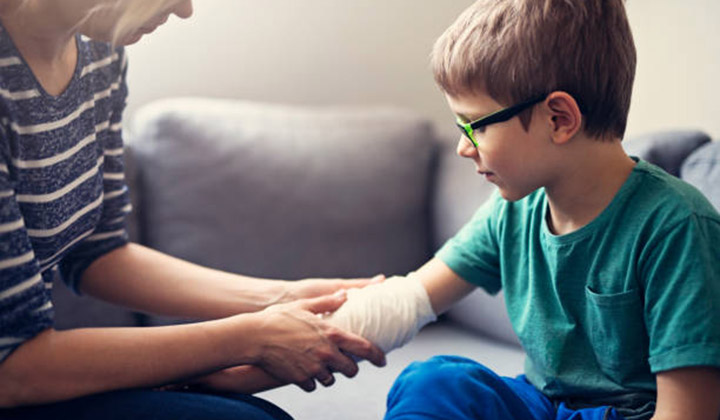Get updates
Have a parenting hack to share? Or a topic you'd like to see?
Burn awareness tips for the whole household

The kitchen is the heart of the home, and it can be really hard to stay away when tasty treats are baking in the oven, or your favorite dinner is simmering on the stovetop. But cooking is one of the leading causes of burns or scalds in the household, so it’s important to keep safety in mind. Whether it’s in the kitchen or another part of your home, follow these tips to keep your children safe from potential burns.
In the kitchen
- Focus on the back burners to keep hot food out of reach and turn pot handles away from the edges.
- Utilize oven mitts or potholders and keep hot foods away from table and counter edges.
- Engage older kids in cooking! Teach them how to safely cook their own meals, and that they should never leave the kitchen while using the stove or oven.
- Microwaves sometimes heat unevenly; use caution when removing food from the microwave, and never use it to heat baby formula or breastmilk.
- Note: Children should not use a microwave until they are tall enough to reach it themselves.
- Never hold a child while you’re cooking on the stove or holding anything hot in your hands. Instead, move them to a highchair or seat in the kitchen, out of the way of the stove/oven. Bonus tip – explain what you’re doing so they learn how you’re practicing safety!
Electrical outlets and household appliances
- Childproofing is key. Keep appliance cords out of a child’s reach and cover all outlets so children cannot insert objects such as silverware, toys or car keys.
- Household items like curling irons and hair dryers heat up quickly and stay warm, so be sure to unplug them as soon as you’re finished using them.
- Keep space heaters a minimum of three feet away from anything flammable. Turn them off when you leave the room.
Hot water safety
- Check the settings on your water heater. Make sure it’s set to 120 degrees Fahrenheit, or the recommended manufacturer settings.
- Think about installing anti-scald devices in your water faucets and showerheads. This can help prevent accidental scalding.
- When giving a baby a bath, check the water temperature on your wrist or elbow. You can also utilize a bath thermometer to check the temperature.
Fireplaces, candles and open flames
- If you have a fireplace, install a sturdy screen. Glass screens can take time to cool down, so avoid going near them until they cool.
- Install safety gates around your fireplace or wood stove to keep small children away from the open flames.
- Candles should be at least 12 inches away from anything that can catch fire. Be sure to always blow them out when you leave the room.
- Matches, lighters and any flammable liquids should be stored out of reach of children.
- Teach kids to never play with matches, lighters or fireworks.
Additionally, install smoke detectors in high traffic areas – outside bedrooms, kitchen, living room and near the furnace. Make sure you have at least one on every level of your home. Place fire extinguishers in the kitchen and other places where there could be fire risk, such as near the furnace and fireplaces. As a family, also sit down and discuss an escape plan if a house fire does occur.
Burn treatment and when to seek medical attention
Sometimes the best safety measures still can’t stop a household burn or scald. If a burn happens, follow these steps immediately to treat the burn:
- Soak the burn in cool water. Let cool water run over the burn as long as necessary to provide relief to the injury.
- Cool smoldering clothing and remove it. Soak smoldering clothing with water until cool, then remove it from the burned area. If your child is wearing a diaper, remove that as well. If it is firmly stuck to the skin, cut away as much as possible.
- Cover the burn. If the area is not oozing, apply antibiotic ointment and cover the burn with a sterile gauze pad or clean, dry cloth.
- If oozing, cover the burn with sterile gauze and seek medical attention. If gauze is not available, use clean sheets or a towel.
If pain occurs for more than a few hours, contact your pediatrician, or seek immediate medical attention for electrical burns or burns of the hands, feet, mouth or genitals. Further medical care may be required if the burn appears deep or if 10% or more of the body is burned.
While burns are scary, they are avoidable, and most often can be treated at home. With proper safety and care, you can avoid or mitigate a burn situation in your household.
